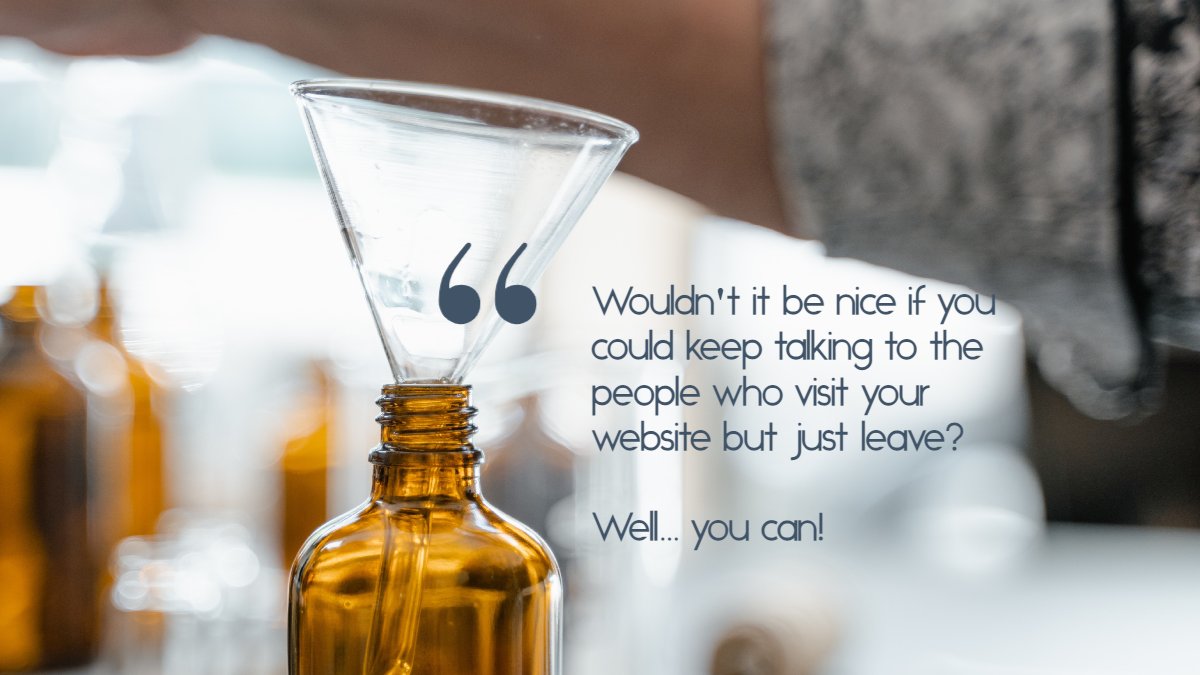How to build a website conversion funnel

A website conversion funnel is a way to capture the people who visit your website and convert them into paying customers—even if they didn’t become a customer the first time around— and it is arguably one of the most important pieces of your marketing strategy. The last thing you want to do is spend time and money driving people to your website and then just cross your fingers and hope that anyone who leaves without buying will remember you when they are ready to purchase sometime in the future (hint: they probably won’t).
So what does it look like? We’re going to show you two main types of website conversion funnels: one for a typical e-commerce website, and one for a B2B service-type company. They are pretty similar, just with a slightly different focus. So let’s get started!
How to build a website conversion funnel for an e-commerce website
1. Build a subscription pop-up with a discount
You’ve probably seen one of these on every e-commerce site you’ve visited in the last few years, for the simple reason that they work. Most people won’t just voluntarily sign up for you to spam them with email, but they will if you give them 15-20% off their first purchase. And you want people to sign up so can stay top of mind with them. Remember, email marketing is one of the most targeted and least expensive revenue generators available to small businesses.
2. Set up a cart-abandonment email automation
The average cart abandonment rate across all industries is 69.57%. Yes, it’s that high. There are lots of reasons for this (sticker shock from surprise shipping/tax costs, using the cart as a favorites page, just not sure they want to purchase, etc), but no matter the reason, it’s effective to remind people about what they’re missing, ideally with a nice product shot. We like to send a series of 2 or 3 or so emails over a period of a week that remind people of the product they added to their cart. This is easy to set up in e-commerce email platforms like Klaivyo.
You can also set up similar emails for browse abandonment—emails that are automatically sent when someone looks at a product on your site but doesn’t add it to their cart. These are less effective in generating additional revenue than cart abandonment automations but still work pretty well.
The other automation (Klaviyo calls them “flows”) that we use a lot is the simple welcome/purchase thank you email. These don’t generate nearly as much revenue as cart and browse abandonment, but they do create additional sales often enough to be worthwhile—and also help people feel good about you and their purchase. This is a great place to show other top-selling products, tell people how to take care of their new purchases, or even let people know why your company is so great.
3. Set up cart-abandonment and browse-abandonment display ads
What you can do in email, you can also do with ads. We like to put together cart/browse abandonment ads on Facebook/Instagram and retargeting display ads on the Google ads platform. If you set up a catalog with your products on Facebook/Instagram, you can show the exact product on the ad that the person was looking at, which works very well to increase conversions. Retargeting ads such as these usually have a much higher ROAS (Return On Ad Spend) than standard outbound advertising.
4. Set up lookalike audiences on social media
If you have enough website visitors, one of the best ways to target social media ads is to build a lookalike audience from them. Lookalike audiences are built by the social media platform to match the parameters that your website visitors have in common, and are usually (with rare exceptions) much better targeting than audiences targeted by interest or other demographic. We like to use audiences built from a combination of website visitors and lookalike visitors, and then serve them with ads featuring new products, promotions, and the like.
5. Make sure you have your email marketing plan in place
Finally, make sure you’re emailing your email list on a regular basis. You absolutely do NOT need to email them daily, or even weekly (in fact, you probably shouldn’t), but try to get something unique and interesting to them at least once a month (interesting being a new product, a flash sale, a bit of information that can help them in their lives, etc).
… and here’s the funnel for a B2B service business
A B2B website conversion funnel isn’t all that different in the basics… but should have a slightly different approach in the details. For instance, content (blogs, vlogs, white papers, and case studies) are much more impactful than discounts and product photos. Here’s what we mean:
Put up a subscription pop-up
As with e-commerce, don’t be afraid of the pop-up! For some B2B businesses, however, a discount might not make sense—particularly if the sales cycle is long, or if your business doesn’t discount much (as with many consultancies). In this case, think of something that it does make sense to offer—such as a free consultation, white paper, article, blog, or webinar. You can even suggest they schedule a time to talk to one of your people to learn more—anything that will get them to hand over their email address.
Set up a subscription welcome email series
Instead of cart-abandonment emails (since that isn’t really a thing in this case), when people do give you their email address, set up a subscription welcome series over the course of the next few weeks so that people can learn more about your company and be reminded of what you do. We like to do about three emails spaced about a week apart. This is a good place to tell people what makes your business special and why it’s a good match for the customer, and to share some pertinent content like blogs, vlogs, or articles that would be of interest to them. It’s also an excellent time to share some customer testimonials!
Set up retargeting display ads and social media ads
Just as with e-commerce, you also want to follow B2B website visitors around the internet. Set up ads on social media and Google display that are targeted to your website visitors. This is the perfect time to share customer testimonials (video is ideal) and your best, slickest “who you are” video. If you offer more than one product or service on your site, tailor your ads and messaging to people that visited the pages associated with each product. This keeps you top of mind and helps cement your messaging.
Depending on your volume of web traffic, you may also be able to build lookalike audiences and test them as outbound ad targeting on social media as well. This isn’t as straightforward for B2B as it is for e-commerce, however, so make sure to test (here’s more on testing!)
Make sure you have your email marketing plan in place
Finally, make sure you’re optimizing any email addresses you gather from your site. Email marketing for B2B companies often doesn’t have the instant gratification of e-commerce email marketing, but it’s a very effective way to reach the elusive business decision-maker directly. In order to keep from being ignored, make sure your email marketing adds value to the reader’s professional life. Share industry information, how-tos, case studies, and webinar announcements rather than pestering people with the same sale pitch over and over. The idea is to send emails that people actually open and read so they can be reminded that you and your product exist when they finally are looking for the product or service you offer.
In conclusion
If you have built a website—even more importantly if you are paying to drive traffic to that website—it is just plain silly to let the majority of that traffic slip away without doing anything to capture it for the future. Even the simplest of website conversion funnels will help stem the flow a little and slowly turn those casual looky-loos into customers. Even if you’re not ready to implement a complicated funnel, throw up a pop-up, up your email game, and put up some retargeting ads… you will be glad you did.
Happy marketing and funnel-building!
Katie and Theron
At Urban Sherpa Marketing Co. we offer fractional marketing director services, which include marketing advisory, strategic planning, program and staff management, and marketing implementation for small to medium businesses and startups. Our goal is to make high-quality marketing possible for every business, no matter the size. Think of us as your outsourced marketing department, strategic marketing adviser, or even your phone-a-friend marketing lifeline. We specialize in building efficient marketing programs to grow your business without blowing the bank.
Share this on:

